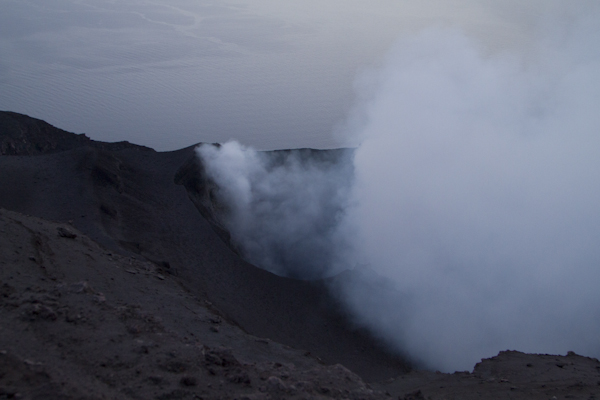
We weren’t even halfway up the mountain yet, and I was already coming to terms with my own mortality.
“Don’t take that trail,” the apartment owner had told us. “It’s very steep. Go around this way instead.” But we had slept late and missed the bus. And this trail began right at the edge of the village. It seemed like the most convenient option at the time.
I began to doubt the wisdom of this decision while hauling myself up a rather precipitous volcanic slope, along a path overhung with tangled juniper and holm oak. My heart was thudding in my ears as my lungs sucked air in ragged gasps. And my legs were screaming a message that sounded like, “You’re 43 years old!”
In my mind, I based my capabilities on a vision of myself 5 years in the past, before I moved to the island of Malta. But I clearly wasn’t the man I used to be—the one who crossed deserts on camels, and who trekked across Alpine heights and subarctic wastes. Five years of living a sedentary life on a heavily populated rock where everyone drives, inhaling car fumes and drinking too much wine, had delivered me a humiliating comeuppance.
I turned to look back down the trail at Tomoko, who right at that moment was shooting photos of my imminent demise. “I’m a middle aged man,” I said, struggling for breath, and for some sort of acceptance of this depressing new phase of my life. “It’s over. I’ve already got one foot in the grave.”
The future flashed before me, and I didn’t like what I saw: visions of comfortable reclining chairs, compression socks, and easy group tours to places like St. Bart’s and Monaco, where I would shuffle up obediently with the other geriatrics to get my daily glass of Metamucil and my bowl of stewed prunes.
But I had forgotten where we were.

Just as my journey had reached it’s lowest ebb, the path levelled off, the walking became easier, and before long the entire island chain was spread out below us: Lipari with it’s busy village, Vulcano with it’s stink of brimstone, posh Panarea of the yacht club crowd, and Stromboli, the island with the biggest smoking problem in Europe.
We were standing on the highest point of the island of Salina—the extinct crater of Monte Fossa del Felci—and we could even see the coast of Sicily, with brooding Mt. Etna in the hazy distance.
The god of the winds—Aeolus, from whom the Aeolian islands get their name—had come to my aid, just as he had aided my hero Odysseus at his lowest moment.

As you know, Odysseus was the hero of The Odyssey, arguably the world’s greatest travel story. By the time he washed up on these fabled islands, he’d been wandering the Mediterranean for 2 or 3 years, trying to make his way home to Ithaca after the Trojan War. He had encountered the Cicones, escaped the somnolent land of the Lotus-eaters, and narrowly survived a run in with the cyclops Polyphemus. But still the gods were against him.
After hearing his story, Aeolus took pity on Odysseus and presented him with a leather bag in which he had imprisoned all of the winds, save that of the west which would guide him home. He secured the bag tightly with a burnished silver wire, and sent Odysseus safely on his way.
That wasn’t the end of our hero’s 10 year ordeal, of course. But the second wind which Aeolus bestowed upon me restored my strength and optimism, and put me back in fine trim for a man of my age.
And so it was with my head held high that I walked along Salina’s extinct crater rim, among chestnut and Aleppo pine, cyclamen blooms and mixed ferns. And in a clearing of exposed rock, we sat and ate lunch as swallows swooped and dove and a kestrel hovered in the distance.
The Aeolian islands are actually the summits of a submerged chain of mountains. They were probably first valued for their naturally occurring obsidian in prehistoric times, the raw material for flaked tools and blades. But their fertile volcanic soils and abundance of fish—paired with temperatures which rarely exceed the mid-20’s Celsius due to cooling breezes—made them eminently habitable.

Despite their appeal, the Aeolians are not an easy place to visit. We live just beyond the far side of Sicily, but the journey still took us half a day: by plane to Catania, followed by a frantic Italian-style car ride to the port of Milazzo, and a shuddering hydrofoil out to the islands. This isolation has kept the archipelago safe from hordes of tourists with their low cost flights. You really have to want to come here.
Salina, the island which I chose as our base, is the second largest in the group, next to Lipari. Its abundance of fresh spring water has made it the most fertile of the Aeolians, famed for its capers and sweet Malvasia wine. Man has lived there since at least 2500 BC, and Bronze Age people settled and abandoned Salina many times. They were followed by Ancient Greeks, and then the Romans, and I understood why they had come. These islands are everything I imagined when I moved to the Mediterranean.
Later that night, back in the village, we chose a small restaurant at random, safe in the knowledge that it is difficult to find a bad meal anywhere in Sicily.
My strength was restored by a perfectly-seared cutlet of tuna, still pink on the inside, and sprinkled with crunchy sea salt. This was followed by fresh linguini with shellfish, served on a bed of pureed green peas—an odd-sounding combination that worked remarkably well. And for dessert, a delicate panacotta made with saffron and strawberry. I laid it all to rest with a tulip of grappa, because we were in Italy, and this distinctive pomace brandy never fails to link together all my memories of the place.
In the evening I sat on the veranda of our little rented apartment on the hillside, looking across at the steep stoney profile of Panarea, and watching smoke rise from the near-perfect cone of Stromboli. The growl of a hydrofoil carried up from the harbour as it opened its massive engines to full throttle and began to skim across the waves.
That perfect cone in the distance was known in ancient times as the “lighthouse of the Mediterranean”. Its constant smoke and fiery output of lava are believed to have persisted for the last 500 years. And it would be our next port of call.

Stromboli seems to convulse and breathe like a living thing. It’s rocky lava-scarred base spreads out in a fertile flat rich in figs, olives and grapes, grown in fields between clusters of simple whitewashed houses that end in black sand beaches.
Evidence of settlement on this unstable island dates back to Neolithic times, and includes Greek and Roman remains. But there is no naturally occurring fresh water on Stromboli, and inhabitants rely on catchments, and on supplies brought by tanker from the mainland.
Given the steepness of the mountain, I expected the summit to be a tough hike. But the path was well-graded, with gentle switchbacks, and the only mildly taxing sections climbed short slopes of black sand. I was never out of breath once. That may have been thanks to the intervention of Aeolus, but was more likely due to our plodding snail’s pace.
It used to be possible to climb to the crater on your own, but after the violent 2003 eruptions all slopes above the 400m mark were placed off limits, and can only be accessed as part of an obligatory guided group.
It was immediately obvious that me and Tomoko were by far the youngest and fittest members of this synthetic-clad entourage. Some of the more questionable participants were even using rented boots. And so we were stuck plodding along at their speed, with imposed rest breaks we didn’t need, at times when we didn’t want them.

We did eventually reach the summit, and as we approached the north crater, acrid smoke blew over us, burning my eyes, choking my lungs, and coating me with flecks of ash that covered the back of my neck in fine grit. Mario, the guide, distributed paper dust masks, but they did little to improve the air. And so we sat on warm sand at the crater’s edge, unwrapped the sandwiches we’d bought in the village, and prepared to watch the show.
But the volcano hadn’t been very active over the past several months. We heard several loud explosions, and saw brief spumes of lava down in the crater. But there was so much smoke hanging in the air that these tiny eruptions only tinted the fumes pink.

And then it was time to go. Each group is allowed a maximum of one hour at the summit, and we had already overstayed. It was a long dusty disorienting hike, sliding down a black sand slope in the dark, with only the flicker of a head torch for direction. The air was still and the dust hung in a low cloud, sticking to my skin and necessitating the use of the mask.
We had our first casualty on the descent. I heard a voice in the darkness shout, “Ethel’s down!” But by the time I got there she was back on her feet, and Mario was instructing her on the use of her hiking poles.
Above us, long crocodiles of hiking groups were working their way off the peak in turn. I could see their torchlight progress in a slow moving glow worm line that continued long after we had reached town and were sipping our post-hike beer.
Thudding explosions woke me many times throughout the night, preceded by deep grumbles from the interior of the island. This was rather unnerving at first, given the total lack of evacuation options, and the obvious instability of this tiny lump in the middle of the Tyrrhenian Sea.
But then I remembered where we were, and I rolled back over and fell asleep. It was only the god Hephaestus working away at his forge.
Photos ©Tomoko Goto 2016

Get your FREE Guide to Creating Unique Travel Experiences today! And get out there and live your dreams...
